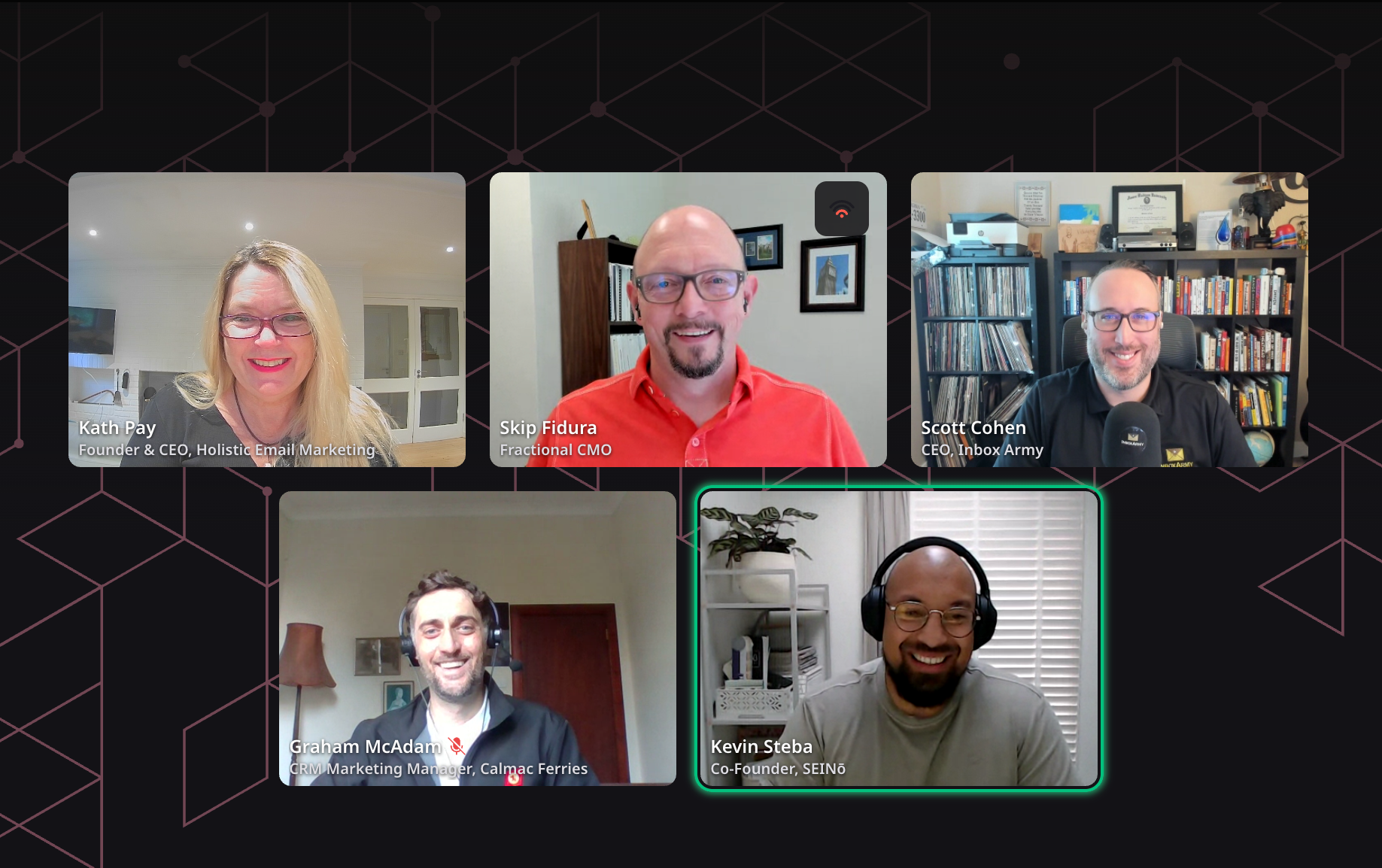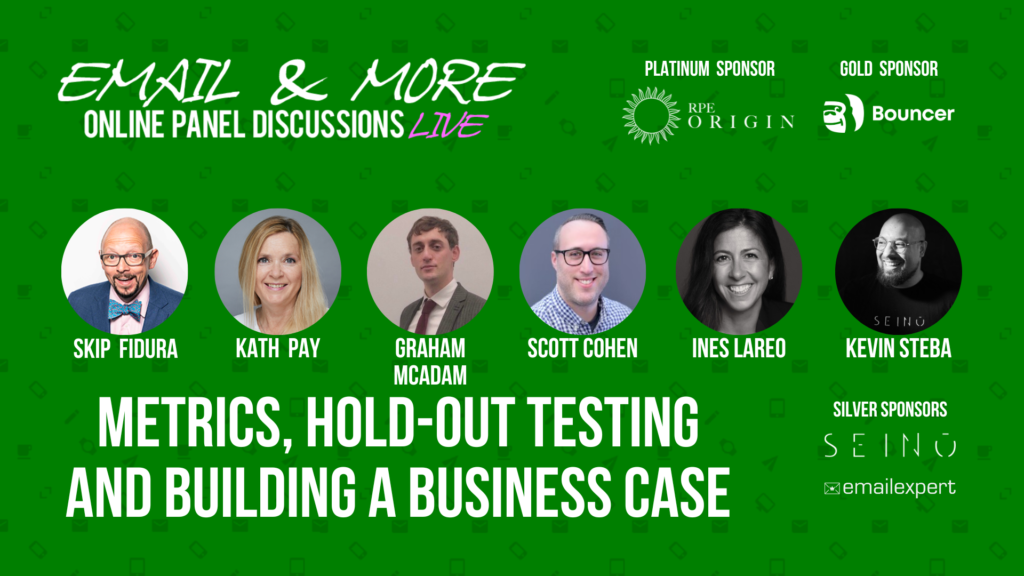Metrics, Testing, and Building a Business Case
How can you prove the true value of your email marketing efforts to senior management? It’s a challenge many email marketers face, especially when traditional metrics like opens and clicks don’t translate easily to business outcomes like revenue. In Episode 8 of Email & More, moderator Skip Fidura led a rich discussion with industry experts Graham McAdam, CRM Marketing Manager at CalMac Ferries, Kevin Steba, Co-founder of Sino, and Scott Cohen, CEO of InboxArmy. Joining them was Kath Pay, bestselling author and CEO of Holistic Email Marketing.
Together, they unpacked how email marketers can leverage metrics and testing to build a compelling business case for their efforts. If you’ve ever struggled to connect your email campaigns to the bottom line, this episode is packed with practical insights for you.
Focus on Metrics that Matter
The consensus was clear: revenue should be the primary metric for email success. As Graham McAdam shared, “Revenue is the one the big bosses love.” For CalMac Ferries, Graham explained, “Most revenue comes in within the first two weeks after a campaign,” but tracking beyond that timeframe often reveals an additional 30% in revenue after four to six weeks. This long-tail tracking gives marketers a fuller picture of campaign impact.
Kath Pay agreed, stressing the need for meaningful metrics. “Don’t just measure opens and clicks—these can lead you astray. Focus on conversions, whether that’s revenue, downloads, or even seats filled at an event.” As email technology advances, marketers now have the tools to track these deeper metrics and prove their business value.
Kevin Steba introduced the idea of “mail pressure”—the balance between sending too many or too few emails. It’s an often-overlooked metric, but vital for optimizing campaign performance without overwhelming customers. By dialing in the right frequency, marketers can maintain engagement and, more importantly, long-term revenue generation.
Testing with Purpose
Testing plays a crucial role in optimizing email performance, but the panel agreed that it needs to be done with purpose. Scott Cohen noted, “Every email you send should have a goal, even if it’s not a direct purchase. Whether it’s driving to a landing page, getting someone to show up for an appointment, or nurturing them toward a purchase later, every touchpoint matters.”
Both Kath and Kevin highlighted the importance of running tests that are aligned with strategic goals, not just for quick wins. Kevin added, “Consider the whole customer journey. Testing isn’t just about what works for one email—it’s about what influences engagement and conversions throughout the lifecycle.”
Skip emphasized that patience is essential when testing, especially for businesses with long buying cycles like travel or B2B industries. “If you rush to make a conclusion after a few days, you’re missing the bigger picture. Wait long enough to capture the long-tail effects,” Kath agreed, noting that marketers should allow tests to run their full course before drawing conclusions.
Building a Business Case
Metrics and testing are vital, but knowing how to present your findings to senior management can be the difference between getting budget approval or not. As Graham pointed out, “If we know that 10% of our email list drives 30% of our business, we can build a case for investing more in email marketing.”
Scott Cohen underscored the importance of benchmarking: “If you’re going to ask for more budget, you need to start benchmarking early. Collect data on the performance of email versus other channels, and show how email is driving revenue, customer retention, and repeat purchases.”
Kath Pay encouraged marketers to keep their metrics accessible and up to date. “If you’re spending weeks waiting for reports from different departments, it’s time to get a tool that gives you real-time data. You need to be able to pull metrics like revenue per email or customer lifetime value at any moment.”
Strategic Takeaways
Here are the key takeaways email marketers can apply to both improve their campaigns and build a strong business case:
- Track Long-Tail Revenue: Don’t stop measuring after a few days. As Graham noted, “30% of revenue comes in after four weeks.” Capturing this data helps justify continued or increased investment in email marketing.
- Shift from Vanity Metrics: It’s time to move beyond opens and clicks. Focus on deeper metrics that tie to business outcomes, such as conversions, customer lifetime value, and revenue.
- Purposeful Testing: Ensure that every test is designed with a specific goal in mind. As Scott said, “Each email should play a part in the broader customer journey.”
- Make the Business Case: Use hard data, like revenue per email and long-tail conversions, to build your case for more budget. Benchmark everything, so when the time comes to ask for more resources, you’re ready with data that proves email’s value.
Don’t miss out on all the insights, questions, and answers from the full episode, Metrics, Testing, and Building a Business Case, available to watch on demand both from our site and YouTube!
Many thanks to our special guests Graham McAdam, Kevin Steba, and Scott Cohen for joining the panel and sharing their expertise. A huge thanks to our sponsors RPE Origin, Sinō, EmailExpert, and Bouncer for their generous support of this series.
Hungry for more? Email & More will return for the final episode of Email & More season 5 to discuss Innovations in Email Marketing on 19 November. Sign up to receive our newsletter, Holistic Insights or follow us on social media to stay informed!






